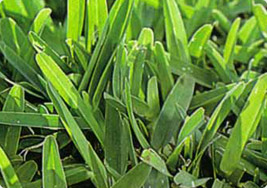Grass Types
Keep in mind that many lawns are a mixture of grasses.
Tall Fescue Grass
Typically a cool-season grass, tall fescue can also be found in hotter regions due to its ability to tolerate heat. It is a bunchgrass often used in athletic fields because it can withstand heavy use and foot traffic. In some lawns, patches of tall fescue may stick out and appear as a grassy weed. It grows in bunches, and is therefore not used very often in grass seed mixes.
• Width: 3/16″ or more; widest blade among cool-season grasses
• Tip/blade: pointed tip
• Color: dark like Kentucky bluegrass
• Feel: coarse, stiff blades
• Growth: grows in clumps
• Additional: prominent veins visible on the blade; won’t survive extreme cold temperatures; jagged edge on the side of the blade




Zoysia
Zoysiagrass forms a lawn that feels like a thick, prickly carpet. Zoysia is found mostly in and from the middle part of the U.S. and east toward the Carolinas. It can be found in the north, but will turn brown once the weather turns cold. It is a very slow-growing grass, and it can take more than a year to establish a lawn of zoysiagrass. It has stiff leaf blades and will produce numerous seed heads if it isn’t mowed.
• Tip/blade: narrow, needle-like tip
• Feel: prickly, stiff blades
• Growth: slow growth
• Additional: prickly feel when walked on barefoot; stolons are often covered with tan-colored “husks”
Centipede
Centipedegrass spreads through stolons, and forms a dense turf. Because it grows horizontally, it requires less mowing and is easy to edge around garden beds and sidewalks. It is found throughout the warm-humid areas of the south. It does not grow well in hot, dry areas and will die if not supplied with adequate moisture. However, its fertilizer requirements are less than other warm-season grasses.
• Tip/blade: pointed blade with notch
• Feel: dense, soft turf
• Growth: grows low, almost horizontal to the ground
• Additional: will quickly go dormant during a drought




Bermuda Grass
Bermudagrass makes for a nice home lawn because it can tolerate a very low mowing height, which is also a reason it is widely used on golf courses in the South. It spreads by both stolons and rhizomes, which helps it to form a thick, dense turf. It is usually found in the south, but may grow as far north as Kansas City. Its maintenance requirements (fertilizing, watering, mowing) are high.
• Width: 1/8″ wide
• Tip/blade: sharp point
• Color: deep green
• Growth: forms a dense, close-cut, high-quality turf
• Additional: most popular lawn grass in the central US. Rough along the edges. Has a distinctive, 3- to 5-fingered seed head.
St. Augustine Grass
St. Augustinegrass is best suited to warm-arid regions such as Florida and the Gulf Coast region. Occasionally, it will be found in areas of California. It is not at all tolerant of cold temperatures, and requires plenty of moisture for survival. It is a very coarse-textured grass that grows via above ground stolons that can reach several feet. It has very broad blades combared to other grasses, with a rounded tip. It is often referred to as “Floratam,” which is a variety of St. Augustinegrass.
• Width: 1/4″ wide blades
• Tip/blade: broad blade with rounded tip
• Color: dark green
• Feel: coarse, spongy turf
• Growth: slow growth, and must be planted from sod or plugs
• Additional: most common grass for lawns in very warm climates


call us at!





